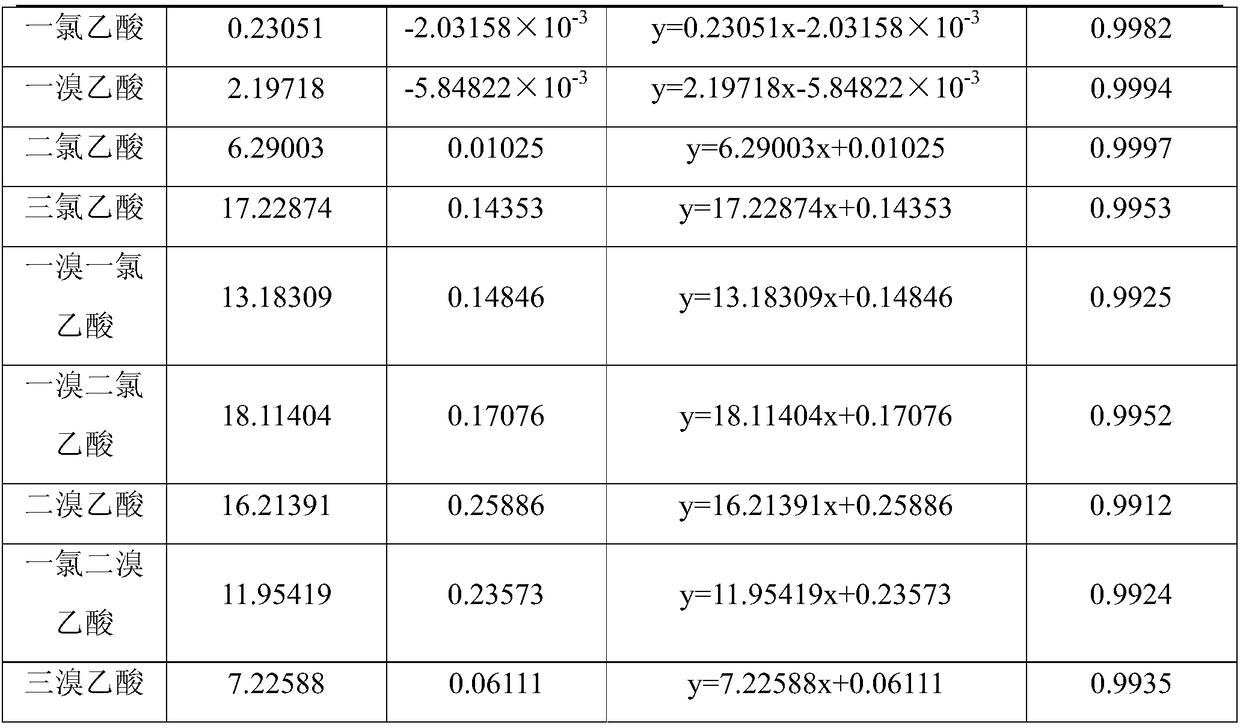Detection method of various haloacetic acids in air or exhaust gas
A detection method, the technology of haloacetic acid, which is applied in the detection field of various haloacetic acids, and can solve the problems of inapplicability of waste gas measurement and lack of detection methods of haloacetic acid, etc.
- Summary
- Abstract
- Description
- Claims
- Application Information
AI Technical Summary
Problems solved by technology
Method used
Image
Examples
Embodiment 1
[0070] The haloacetic acid compounds in the exhaust gas of fixed pollution sources are absorbed and collected by connecting two porous glass plate absorption bottles each equipped with 0.1mol / L NaOH aqueous solution with a volume of 40ml in series. Connect the series-connected porous glass plate absorption bottle to the flue gas sampler, set the gas collection flow rate to 0.5L / min to collect the waste gas from pollution sources for 40min, and collect 20L of gas samples.
[0071] Add nine haloacetic acid standard substances to 0.1mol / L NaOH aqueous solution to prepare 40ml of standard substances with concentrations of 0.5μg / L, 1μg / L, 5μg / L, 10μg / L, 20μg / L, 50μg / L, 100μg / L L, 200μg / L, 1000μg / L, 2000μg / L nine haloacetic acid standard alkaline aqueous solutions. Add 2ml of concentrated sulfuric acid to the above alkaline aqueous solution to adjust the pH to less than 0.5, convert the haloacetate into haloacetic acid, then quickly add 8g of baked sodium chloride to shake and disso...
Embodiment 2
[0096] The haloacetic acid compounds in the exhaust gas of fixed pollution sources are absorbed and collected by connecting two porous glass plate absorption bottles each equipped with 0.5mol / L NaOH aqueous solution with a volume of 40ml in series. Connect the series-connected porous glass plate absorption bottle to the flue gas sampler, set the gas collection flow rate to 0.4L / min to collect the waste gas from pollution sources for 50min, and collect 20L of samples. After sampling, follow the same sample analysis steps as in Example 1 to analyze and calculate the concentrations of the nine kinds of haloacetic acids in the exhaust gas from the exhaust pipe of the fixed pollution source. The metal catalyst used in the drawing of the working curve and the determination of the samples to be tested is ferric sulfate, and the addition amount is 8 mg; and 6 ppm of p-chlorotetraphenylcopper porphyrin and 0.8 mg of benzenesulfonic acid phenolic resin (PAFR) are added in the mass of the...
Embodiment 3
[0099] The haloacetic acid compounds in the exhaust gas of fixed pollution sources are absorbed and collected with a single porous glass plate absorption bottle filled with a volume of 40ml of 1mol / L NaOH aqueous solution. Connect the porous glass plate absorption bottle to the flue gas sampler, set the gas sampling flow rate to 0.4L / min to collect the waste gas from pollution sources for 50min, and collect 20L of gas samples. After sampling, follow the same sample analysis steps as in Example 1 to analyze and calculate the concentrations of nine kinds of haloacetic acids in the waste gas from fixed pollution sources. The working curve drawing and the metal catalyst ferric chloride addition amount used for the determination of the sample to be tested are 7mg; The content of chlorotetraphenylcopper porphyrin is 5ppm of the mass of the carrier solvent.
[0100] The measurement results of haloacetic acid in exhaust gas are as follows: monochloroacetic acid 0.1593mg / m 3 , Monobr...
PUM
 Login to View More
Login to View More Abstract
Description
Claims
Application Information
 Login to View More
Login to View More - R&D
- Intellectual Property
- Life Sciences
- Materials
- Tech Scout
- Unparalleled Data Quality
- Higher Quality Content
- 60% Fewer Hallucinations
Browse by: Latest US Patents, China's latest patents, Technical Efficacy Thesaurus, Application Domain, Technology Topic, Popular Technical Reports.
© 2025 PatSnap. All rights reserved.Legal|Privacy policy|Modern Slavery Act Transparency Statement|Sitemap|About US| Contact US: help@patsnap.com


